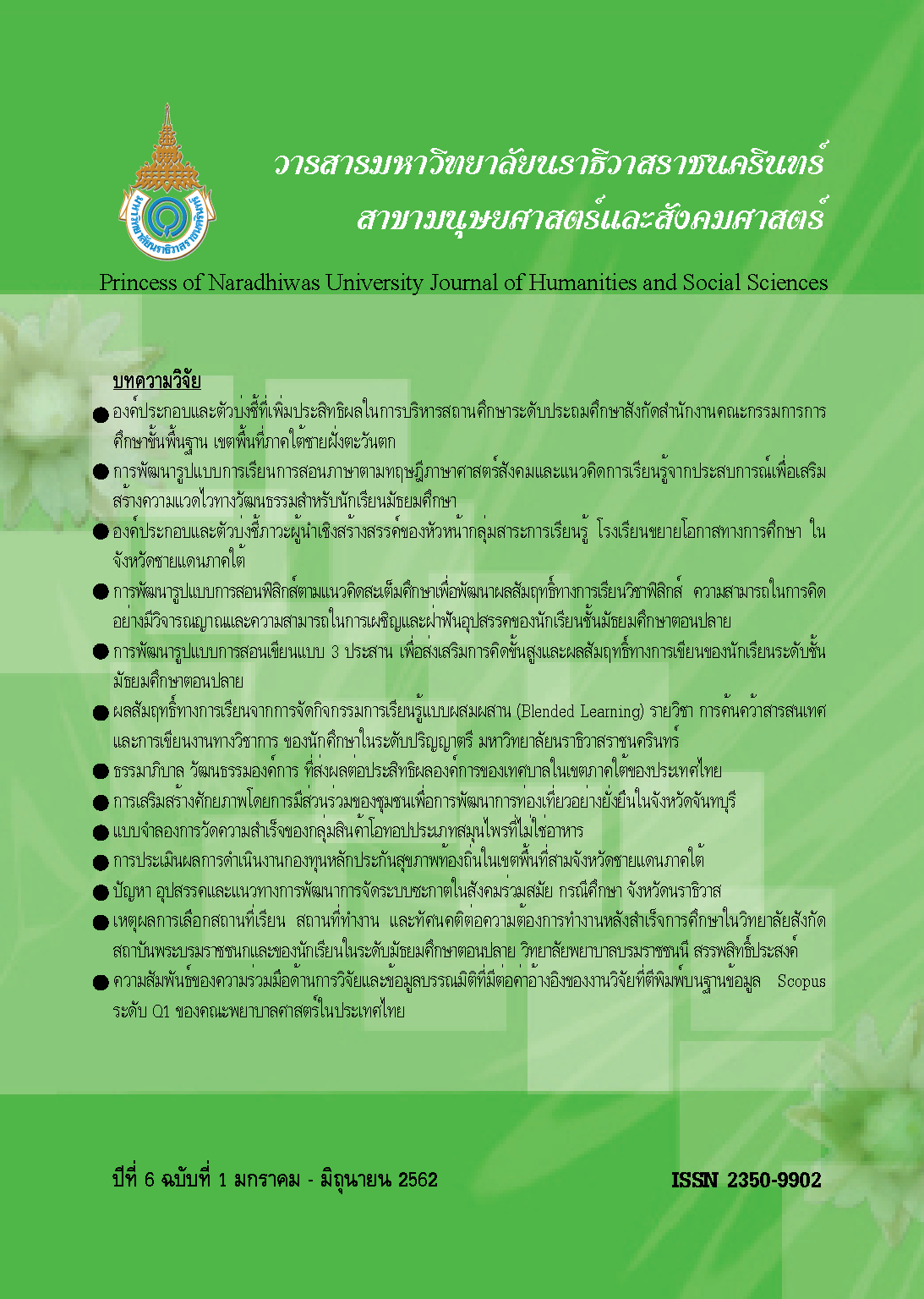Learning Achievement from Blended Learning in Information Searching and Academic Writing of Undergraduate Students at Princess of Naradhiwas University
Main Article Content
Abstract
This research aimed to 1) study students’ learning outcome; through blended learning 2) to compare effectiveness of students’ achievement through blended learning and 3) to evaluate blended learning in Information Searching and Academic Writing of Undergraduate Students at Princess of Naradhiwas University. The sample of this study was the first year accounting students group 1 Faculty of Management Science, Princess of Naradhiwas University who were registered in Information Searching and Academic Writing course in the second semester of the year 2017 there were 48 students. The research instruments were 1) blended learning’ teaching plan, 2) Evaluation form of students’ learning outcome,
3) information searching and academic writing comprehension test and 4) the blended learning questionnaire. The instruments were analyzed by reliability test. The reliability of evaluation form of students’ learning outcome was 0.782 that analyzed by Cronbach’s alpha coefficient and the reliability of the blended learning questionnaire was 0.863 that analyzed by KR-20 . The data of this study was analyzed by using Mean, Standard deviation (S.D.), Percentage and Effectivenesss Index (E.I.).
The study found that:
1) The study of students’ learning outcome; through blended learning found that after teaching blended learning activities, the students were better on groups working, analytical thinking, practicing, submitting assignments on time, and the students learning outcome were highest level of all measuring and evaluating.
2) The effectiveness of students’ achievement through blended learning were higher than before using blended learning activities with 52.98%.
3) The evaluation blended learning found that 3.1) teacher, most students assume that teacher taught them easily to understand the lessons 3.2) content, most students assume that comprehensive content was suitable and they can adapt content in their everyday life; 3.3) teaching method, most students assume that teacher has good teaching techniques.
Article Details
References
กิติพร โชประการ. (2555). ความคิดเห็นของนักศึกษาต่อ กระบวนการเรียนการสอน รายวิชาศิลปะการดำเนินชีวิต. วารสารศิลปศาสตร์ มหาวิทยาลัยอุบลราชธานี, 8(2), 145-165.
เดชดนัย จุ้ยชุม, ศิริกัญญา แก่นทอง และเกษรา บ่าวแช่มช้อย. (2559). การพัฒนาผลสัมฤทธิ์ทางการเรียน เรื่อง ทักษะการคิดของนักศึกษาในรายวิชาทักษะการคิด (Thinking Skills) รหัสวิชา 11-024-112 ภาคเรียนที่ 1 ปีการศึกษา 2558 ด้วยการเรียนรู้แบบมีส่วนร่วม (Active Learning). วารสารมหาวิทยาลัยนราธิวาสราชนครินทร์ สาขามนุษยศาสตร์และสังคมศาสตร์, 3(2), 47-57.
ชาญชัย ศรีไสยเพชร. (2527). ทักษะและเทคนิคการสอน (พิมพ์ครั้งที่ 2). กรุงเทพฯ: พิทักษอักษร.
ทิศนา แขมมณี. (2548). การจัดการเรียนรู้โดยใช้การวิจัยเป็นส่วนหนึ่งของกระบวนการเรียนรู้. กรุงเทพฯ: โรงพิมพ์แห่งจุฬาลงกรณ์มหาวิทยาลัย.
ธีระวงศ สายนาโก, ขวัญหญิง ศรีประเสริฐภาพ และวิไลลักษณ ลังกา. (2556). การพัฒนารูปแบบการเรียนการสอนผสมผสาน เพื่อฝึกปฏิบัติงานแอนิเมชั่นเบื้องต้นสำหรับนิสิตปริญญาตรี สาขาวิชาเทคโนโลยีสื่อสารการศึกษา. วารสารบัณฑิตศึกษา มหาวิทยาลัยราชภัฏวไลยอลงกรณ ในพระบรมราชูปถัมภ, 7(2), 16-30.
บัณฑิต ทิพากร. (2550). การพัฒนาคณาจารย์ในสถาบันอุดมศึกษา. ใน ไพฑูรย์ สินลารัตน์ (บรรณาธิการ). อาจารย์มืออาชีพ: แนวคิด เครื่องมือ และการพัฒนา. กรุงเทพฯ: โรงพิมพ์แห่งจุฬาลงกรณ์มหาวิทยาลัย.
บุญชม ศรีสะอาด. (2535). การวิจัยเบื้องต้น. (พิมพ์ครั้งที่ 2). กรุงเทพฯ : โอเดียนสโตร์.
ไพฑูรย์ สินลารัตน์. (2545). การเรียนการสอนที่มีการวิจัยเป็นฐาน. กรุงเทพฯ: โรงพิมพ์แห่งจุฬาลงกรณ์มหาวิทยาลัย.
ยืน ภู่สุวรรณ. (2551). การประยุกต์ใช้เทคโนโลยีอินเทอร์เน็ตและเทคโนโลยีมัลติมีเดียเพื่อการศึกษาและประเด็นการวิจัย. ขอนแก่น: มหาวิทยาลัยขอนแก่น.
เลอสันต์ ฤทธิขันธ์, ทรงศักดิ์ สองสนิท และประวิทย์ สิมมาทัน. (2561). การพัฒนารูปแบบการเรียนรู้แบบผสมผสานร่วมกับทฤษฎีการขยายความคิดเพื่อส่งเสริมการถ่ายโยงการเรียนรู้ และทักษะการแก้ปัญหา สำหรับนักศึกษาระดับประกาศนียบัตรวิชาชีพ. วารสารการวัดผลการศึกษา มหาวิทยาลัยมหาสารคาม, 24(1), 269-284.
สัมฤทธิ์ เสนกาศ, กันต์พงษ์ วรรัตน์ปัญญา และสรเดช ครุฑจ้อน. (2554). การพัฒนาตัวแบบการเรียนรู้แบบผสมผสานเนื้อหาและกิจกรรมการเรียนด้านการเขียนโปรแกรมคอมพิวเตอร์. วารสารบรรณศาสตร์ มศว, 4(2), 80-94.
Bersin, J. (2004). The blended learning book: best practices, proven methodologies and lessons learned. San Francisco, CA: Pfeiffer Publishing.

